 c1f1rsa.htm
- Figure shows the basic design of a rapid sediment analyzer (RSA;
Schlee, 1966). c1f1rsa.htm
- Figure shows the basic design of a rapid sediment analyzer (RSA;
Schlee, 1966).
|
 c1f2empsa.htm
- Figure shows the basic design of an electro-resistance
multichannel particle size analyzer (EMPSA). c1f2empsa.htm
- Figure shows the basic design of an electro-resistance
multichannel particle size analyzer (EMPSA).
|
|
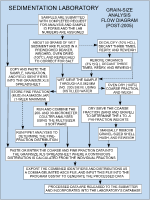 c1f3gsa.htm
- Generalized flow diagram outlining the laboratory techniques and
the computer software used in the sedimentation laboratory at the
Woods Hole Coastal and Marine Science Center. c1f3gsa.htm
- Generalized flow diagram outlining the laboratory techniques and
the computer software used in the sedimentation laboratory at the
Woods Hole Coastal and Marine Science Center. |
|
 c1f4form.htm
- Form used to request grain-size analyses. Form supplies sample
identifiers and define the purpose of the project and the laboratory
procedures to be employed. c1f4form.htm
- Form used to request grain-size analyses. Form supplies sample
identifiers and define the purpose of the project and the laboratory
procedures to be employed. |
|
 c1f5form.htm
- Form used before 2005 to record sample identifiers and assign the
corresponding lab numbers. Information supplied includes: submitter,
cruise id, project id, latitude, longitude, water depth in meters,
sampling device area, top depth within the sediment column in
centimeters, and bottom depth within the sediment column in
centimeters. Information from this form is entered into a computer
using the programs
GSANV
or ENTRY. c1f5form.htm
- Form used before 2005 to record sample identifiers and assign the
corresponding lab numbers. Information supplied includes: submitter,
cruise id, project id, latitude, longitude, water depth in meters,
sampling device area, top depth within the sediment column in
centimeters, and bottom depth within the sediment column in
centimeters. Information from this form is entered into a computer
using the programs
GSANV
or ENTRY. |
|
 c1f6form.htm
- Form used before 2005 to record and calculate analytical data during
grain-size and carbonate analyses. Grain size data from this form
are entered into a computer using the programs
RSAM and
RSA2000. c1f6form.htm
- Form used before 2005 to record and calculate analytical data during
grain-size and carbonate analyses. Grain size data from this form
are entered into a computer using the programs
RSAM and
RSA2000. |
|
 c1f7oven.htm
- Photograph showing a typical convection oven used to dry samples
and a desiccator used to store samples prior to weighing. c1f7oven.htm
- Photograph showing a typical convection oven used to dry samples
and a desiccator used to store samples prior to weighing. |
|
 c1f8wets.htm
- Photograph showing an analyst in the process of wet sieving a
sample. c1f8wets.htm
- Photograph showing an analyst in the process of wet sieving a
sample. |
|
 c1f9chart.htm
- Correlation chart showing the relationships between phi sizes,
millimeter diameters, size classifications (Wentworth, 1922), and
ASTM and Tyler sieve sizes. Chart also shows the
corresponding intermediate diameters, grains per milligram, settling
velocities, and threshold velocities for traction. c1f9chart.htm
- Correlation chart showing the relationships between phi sizes,
millimeter diameters, size classifications (Wentworth, 1922), and
ASTM and Tyler sieve sizes. Chart also shows the
corresponding intermediate diameters, grains per milligram, settling
velocities, and threshold velocities for traction. |
|
 c1f10still.htm
- Photograph showing a typical distillation unit used to produce
distilled water and sonic probe used to disaggregate particles prior
to
EMPSA and pipette analysis. c1f10still.htm
- Photograph showing a typical distillation unit used to produce
distilled water and sonic probe used to disaggregate particles prior
to
EMPSA and pipette analysis. |
|
 c1f11filter.htm
- Basic filtration system used to remove submicron-sized particles
from the electrolyte/dispersant used during
EMPSA and pipette analyses. c1f11filter.htm
- Basic filtration system used to remove submicron-sized particles
from the electrolyte/dispersant used during
EMPSA and pipette analyses. |
|
 c1f12rsa.htm
- Photograph of a rapid sediment analyzer (RSA). This instrument
(Schlee, 1966) uses a pressure transducer to monitor the settling of
sediment with time. A amplifier demodulator on the shelf next to the
settling tube relays electrical information to and analog-to-digital
converter in the computer. c1f12rsa.htm
- Photograph of a rapid sediment analyzer (RSA). This instrument
(Schlee, 1966) uses a pressure transducer to monitor the settling of
sediment with time. A amplifier demodulator on the shelf next to the
settling tube relays electrical information to and analog-to-digital
converter in the computer. |
|
 c1f13shaker.htm - Photograph of a bank of sieves mounted in a
sieve shaker. The shaker rests in an insulated box for sound
proofing.
c1f13shaker.htm - Photograph of a bank of sieves mounted in a
sieve shaker. The shaker rests in an insulated box for sound
proofing. |
|
 c1f14form.htm - Hard copy printout of a coarse-fraction raw
data record produced by the computer program
RSA2000.
c1f14form.htm - Hard copy printout of a coarse-fraction raw
data record produced by the computer program
RSA2000. |
|
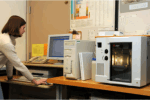 c1f15coulter.htm - Photograph of a Beckman Coulter Multisizer 3 and its associated computer hardware.
c1f15coulter.htm - Photograph of a Beckman Coulter Multisizer 3 and its associated computer hardware. |
|
 c1f16form.htm - Form used to record and calculate sample
identifiers and data generated during a pipette analysis. Data from
pipette analyses can be entered into a computer using the program
ENTRY.
c1f16form.htm - Form used to record and calculate sample
identifiers and data generated during a pipette analysis. Data from
pipette analyses can be entered into a computer using the program
ENTRY. |
|
 c1f17form.htm - Hard copy of a fine-fraction raw data record
produced by the computer program
CLTRMS2K.
c1f17form.htm - Hard copy of a fine-fraction raw data record
produced by the computer program
CLTRMS2K. |
|
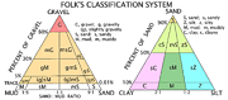 c1f18folk.htm - Sediment classification scheme modified from
Folk (1954, 1974) used by the program
SEDCLASS.
c1f18folk.htm - Sediment classification scheme modified from
Folk (1954, 1974) used by the program
SEDCLASS. |
|
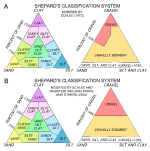 c1f19shep.htm - A) Sediment classification scheme modified from Shepard (1954) and published by Schlee (1973). (B) Sediment classification scheme modified from Shepard (1954) and used by the Schlee and Webster (1967) program
GSTAT,
GSTATM,
and
GSSTAT (Poppe and others, 2004).
c1f19shep.htm - A) Sediment classification scheme modified from Shepard (1954) and published by Schlee (1973). (B) Sediment classification scheme modified from Shepard (1954) and used by the Schlee and Webster (1967) program
GSTAT,
GSTATM,
and
GSSTAT (Poppe and others, 2004). |
|
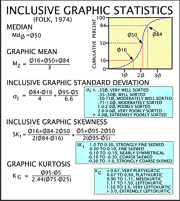 c1f20figstatis.htm
- Equations used to calculate inclusive graphics statistics (Folk,
1974) for grain-size distributions. Figure also shows verbal ranges
assigned to these statistics. c1f20figstatis.htm
- Equations used to calculate inclusive graphics statistics (Folk,
1974) for grain-size distributions. Figure also shows verbal ranges
assigned to these statistics. |
|
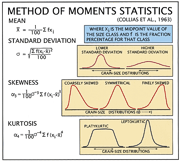 c1f21mmstatis.htm
- Equations used to calculate method of moments statistics (Collias
et al., 1963) for grain-size distributions. Figure also shows
graphical representations of statistics. c1f21mmstatis.htm
- Equations used to calculate method of moments statistics (Collias
et al., 1963) for grain-size distributions. Figure also shows
graphical representations of statistics. |
|
 c1f22symbol.htm
- Basic lithologic symbols commonly used on sediment distribution
maps and in lithologic columnar sections. c1f22symbol.htm
- Basic lithologic symbols commonly used on sediment distribution
maps and in lithologic columnar sections. |
|
 c1f23swflow.htm
- Generalized flow diagram showing the available grain-size analysis
software and its sequence of operation. c1f23swflow.htm
- Generalized flow diagram showing the available grain-size analysis
software and its sequence of operation. |
|
 c1f24form.htm
- Hard copy of a data record produced by the computer programs
GSTAT
and
GSTATM.
Hard copy shows sample identifiers, size distribution, method of
moments and inclusive graphics statistics, and verbal equivalents. c1f24form.htm
- Hard copy of a data record produced by the computer programs
GSTAT
and
GSTATM.
Hard copy shows sample identifiers, size distribution, method of
moments and inclusive graphics statistics, and verbal equivalents. |
|
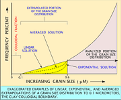 c1f25extrapol.htm
- Stylized plot showing that portion of the clay fraction typically
truncated by electro-resistance particle size analyzers. Also shown
are examples of linear, exponential, and average of the linear and
exponential extrapolations to 0.1 microns, the clay-colloidal
boundary by the program
CLAYES2K.
Errors inherent in the linear and exponential solutions have been
exaggerated to show their effect. c1f25extrapol.htm
- Stylized plot showing that portion of the clay fraction typically
truncated by electro-resistance particle size analyzers. Also shown
are examples of linear, exponential, and average of the linear and
exponential extrapolations to 0.1 microns, the clay-colloidal
boundary by the program
CLAYES2K.
Errors inherent in the linear and exponential solutions have been
exaggerated to show their effect.
|
|
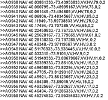 c1f26form.htm
- Raw data records produced by the computer program
GSANV. c1f26form.htm
- Raw data records produced by the computer program
GSANV. |
|
 c1f27form.htm
- Raw coarse-fraction data records from the Rapid Sediment Analyzer
(RSA) produced by the computer program
RSA2000
and output into a file by the program
SEDITY2K.
The first line, which is the master file name assigned by the
operator with the program
SEDITY2K,
must be deleted before further processing. c1f27form.htm
- Raw coarse-fraction data records from the Rapid Sediment Analyzer
(RSA) produced by the computer program
RSA2000
and output into a file by the program
SEDITY2K.
The first line, which is the master file name assigned by the
operator with the program
SEDITY2K,
must be deleted before further processing. |
|
 c1f28form.htm
- Raw fine-fraction data records from the Coulter Counter (200- and
30-micron analyses) produced by the computer program
CLTRMS2K
and output into a file by the program
SEDITY2K.
The first line, which is the master file name assigned by the
operator with the program
SEDITY2K,
must be deleted before further processing. c1f28form.htm
- Raw fine-fraction data records from the Coulter Counter (200- and
30-micron analyses) produced by the computer program
CLTRMS2K
and output into a file by the program
SEDITY2K.
The first line, which is the master file name assigned by the
operator with the program
SEDITY2K,
must be deleted before further processing. |
|
 c1f29form.htm
- Data file produced by the computer programs
GSTAT
and
GSTATM
and used as input for the computer program
CLAYES2K.
Fields are delimited by commas; records are delimited by dollar
signs. A header file has been inserted as the first record to show
the field attributes and their order. c1f29form.htm
- Data file produced by the computer programs
GSTAT
and
GSTATM
and used as input for the computer program
CLAYES2K.
Fields are delimited by commas; records are delimited by dollar
signs. A header file has been inserted as the first record to show
the field attributes and their order. |
|
 c1f30form.htm
- Hard copy of a data record produced by the computer program
CLAYES2K.
The sample identifiers and the original and revised data are shown. c1f30form.htm
- Hard copy of a data record produced by the computer program
CLAYES2K.
The sample identifiers and the original and revised data are shown. |
|
 c1f31form.htm
- Data file produced by the computer program
CLAYES2K.
Fields are delimited by commas; records are delimited by dollar
signs. A header file has been inserted on the first line to show the
field attributes. c1f31form.htm
- Data file produced by the computer program
CLAYES2K.
Fields are delimited by commas; records are delimited by dollar
signs. A header file has been inserted on the first line to show the
field attributes. |
|
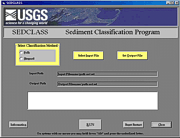 c1f32sedclass.htm
- Window for the
SEDCLASS program. The user can select classification schemes,
designate input and output files, and start or cancel the
application. Clicking the input and output file options opens text
boxes that allow the user to enter file names and browse for
destination directories. c1f32sedclass.htm
- Window for the
SEDCLASS program. The user can select classification schemes,
designate input and output files, and start or cancel the
application. Clicking the input and output file options opens text
boxes that allow the user to enter file names and browse for
destination directories. |
|
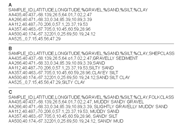 c1f33form.htm
- Examples of input and output
SEDCLASS
files. c1f33form.htm
- Examples of input and output
SEDCLASS
files.
A.) A typical input file with seven
fields in comma-delimited
ASCII. Fields must be in this order, but population of the
navigation fields is optional. Note the last record has no
navigation.
B.) Output file generated from the input
file above with the Shepard (1954) option selected.
C.) Output file generated from the input
file above with the Folk (1954) option selected. Note the eighth
field for sediment classification generated in the output files. |
|
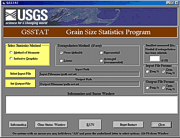 c1f34gsstat.htm
- Window for
GSSTAT
program. User can select statistical and extrapolation methods,
designate input and output files, and start or cancel application.
Clicking input and output file options opens text boxes that allow
user to enter file names and browse for destination directories. c1f34gsstat.htm
- Window for
GSSTAT
program. User can select statistical and extrapolation methods,
designate input and output files, and start or cancel application.
Clicking input and output file options opens text boxes that allow
user to enter file names and browse for destination directories. |
|
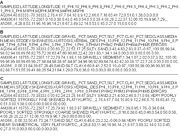 c1f35form.htm
- Examples of input and output
GSTAT
files. c1f35form.htm
- Examples of input and output
GSTAT
files.
A.) Typical input file with twenty fields
in comma-delimited
ASCII. First record is a header; next three records contain
size distributions in frequency percent. Fields must be in this
order, but population of fields is optional. Note last record has no
navigation.
B.) Output file generated from input file
above with method of moments (Collias and others, 1963; Schlee and
Webster, 1967), cumulative frequency percent, and mean of linear and
exponential extrapolation options selected. Note 13 and 12 phi
fields are populated.
C.) Output file with thirty-three fields
generated from input file above with inclusive graphics (Folk,
1974), frequency percent, and no extrapolation options selected.
Note that verbal description field is populated. |
|
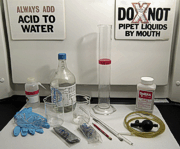 c1f36insolres.htm
- Image shows the equipment typically necessary to perform analyses
for carbonate content by insoluble residue. Concentrated HCL, which
is diluted with distilled water as part of this analysis, is a
strong corrosive irritant. Appropriate personal protection gear
should be worn when handling this chemical; the analyses should be
conducted in a fume hood. c1f36insolres.htm
- Image shows the equipment typically necessary to perform analyses
for carbonate content by insoluble residue. Concentrated HCL, which
is diluted with distilled water as part of this analysis, is a
strong corrosive irritant. Appropriate personal protection gear
should be worn when handling this chemical; the analyses should be
conducted in a fume hood. |
|
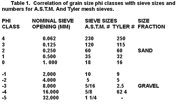 c1tab1.htm
- Correlation of grain size phi classes with sieve sizes and numbers
for American Society for Testing and Materials (ASTM) and Tyler mesh
sieves. c1tab1.htm
- Correlation of grain size phi classes with sieve sizes and numbers
for American Society for Testing and Materials (ASTM) and Tyler mesh
sieves. |
|
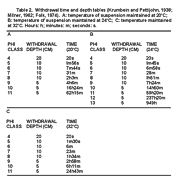 c1tab2.htm
- Withdrawal time and depth tables (Krumbein and Pettijohn, 1938;
Milner, 1962; Folk, 1974). c1tab2.htm
- Withdrawal time and depth tables (Krumbein and Pettijohn, 1938;
Milner, 1962; Folk, 1974).
A.) Temperature of suspension maintained
at 20o C
B.) Temperature of suspension maintained
at 24o C
C.) Temperature maintained at 32o
C. hours: h; minutes: m; seconds: s |
